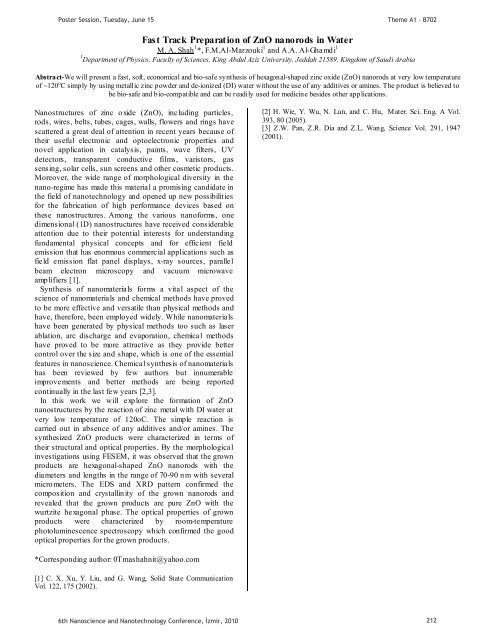Photonic crystals in biology
Photonic crystals in biology
Photonic crystals in biology
You also want an ePaper? Increase the reach of your titles
YUMPU automatically turns print PDFs into web optimized ePapers that Google loves.
Poster Session, Tuesday, June 15<br />
Theme A1 - B702<br />
Fas t Track Preparat ion of ZnO nanorods <strong>in</strong> Water<br />
M. A. Shah 1 *, F.M.Al-Marzouki 1 and A.A. Al-Ghamdi 1<br />
1 Department of Physics, Faculty of Sciences, K<strong>in</strong>g Abdul Aziz University, Jeddah 21589, K<strong>in</strong>gdom of Saudi Arabia<br />
Abstract-We will present a fast, soft, economical and bio-safe synthesis of hexagonal-shaped z<strong>in</strong>c oxide (ZnO) nanorods at very low temperature<br />
of ~120 o C simply by us<strong>in</strong>g metallic z<strong>in</strong>c powder and de-ionized (DI) water without the use of any additives or am<strong>in</strong>es. The product is believed to<br />
be bio-safe and bio-compatible and can be readily used for medic<strong>in</strong>e besides other applications.<br />
Nanostructures of z<strong>in</strong>c oxide (ZnO), <strong>in</strong>clud<strong>in</strong>g particles,<br />
rods, wires, belts, tubes, cages, walls, flowers and r<strong>in</strong>gs have<br />
scattered a great deal of attention <strong>in</strong> recent years because of<br />
their useful electronic and optoelectronic properties and<br />
novel application <strong>in</strong> catalysis, pa<strong>in</strong>ts, wave filters, UV<br />
detectors, transparent conductive films, varistors, gas<br />
sens<strong>in</strong>g, solar cells, sun screens and other cosmetic products.<br />
Moreover, the wide range of morphological diversity <strong>in</strong> the<br />
nano-regime has made this material a promis<strong>in</strong>g candidate <strong>in</strong><br />
the field of nanotechnology and opened up new possibilit ies<br />
for the fabrication of high performance devices based on<br />
these nanostructures. Among the various nanoforms, one<br />
dimensional (1D) nanostructures have received considerable<br />
attention due to their potential <strong>in</strong>terests for understand<strong>in</strong>g<br />
fundamental physical concepts and for efficient field<br />
emission that has enormous commercial applications such as<br />
field emission flat panel displays, x-ray sources, parallel<br />
beam electron microscopy and vacuum microwave<br />
amp lifiers [1].<br />
Synthesis of nanomaterials forms a vital aspect of the<br />
science of nanomaterials and chemical methods have proved<br />
to be more effective and versatile than physical methods and<br />
have, therefore, been employed widely. While nanomaterials<br />
have been generated by physical methods too such as laser<br />
ablation, arc discharge and evaporation, chemical methods<br />
have proved to be more attractive as they provide better<br />
control over the size and shape, which is one of the essential<br />
features <strong>in</strong> nanoscience. Chemical synthesis of nanomaterials<br />
has been reviewed by few authors but <strong>in</strong>numerable<br />
improvements and better methods are be<strong>in</strong>g reported<br />
cont<strong>in</strong>ually <strong>in</strong> the last few years [2,3].<br />
In this work we will explore the formation of ZnO<br />
nanostructures by the reaction of z<strong>in</strong>c metal with DI water at<br />
very low temperature of 120oC. The simple reaction is<br />
carried out <strong>in</strong> absence of any additives and/or am<strong>in</strong>es. The<br />
synthesized ZnO products were characterized <strong>in</strong> terms of<br />
their structural and optical properties. By the morphological<br />
<strong>in</strong>vestigations us<strong>in</strong>g FESEM, it was observed that the grown<br />
products are hexagonal-shaped ZnO nanorods with the<br />
diameters and lengths <strong>in</strong> the range of 70-90 nm with several<br />
micrometers. The EDS and XRD pattern confirmed the<br />
composition and crystall<strong>in</strong> ity of the grown nanorods and<br />
revealed that the grown products are pure ZnO with the<br />
wurtzite hexagonal phase. The optical properties of grown<br />
products were characterized by room-temperature<br />
photolum<strong>in</strong>escence spectroscopy which confirmed the good<br />
optical properties for the grown products.<br />
[2] H. Wie, Y. Wu, N. Lun, and C. Hu, Mater. Sci. Eng. A Vol.<br />
393, 80 (2005).<br />
[3] Z.W. Pan, Z.R. Dia and Z.L. Wang, Science Vol. 291, 1947<br />
(2001).<br />
*Correspond<strong>in</strong>g author: 0Tmashahnit@yahoo.com<br />
[1] C. X. Xu, Y. Liu, and G. Wang, Solid State Communication<br />
Vol. 122, 175 (2002).<br />
6th Nanoscience and Nanotechnology Conference, zmir, 2010 212













